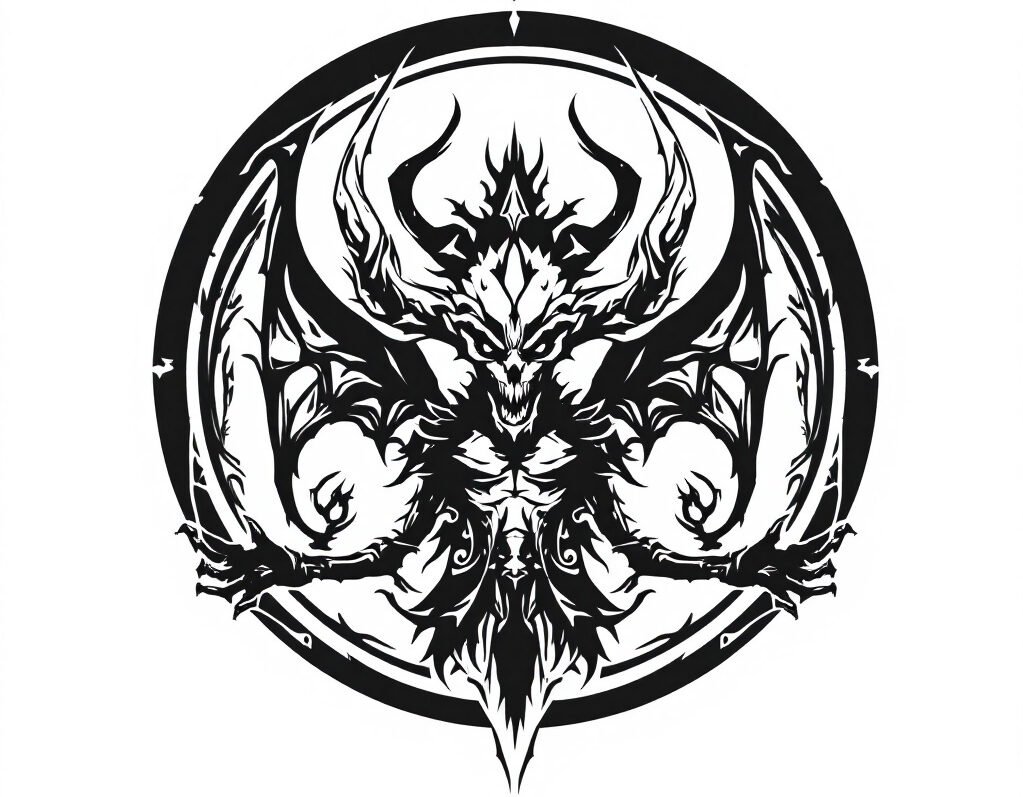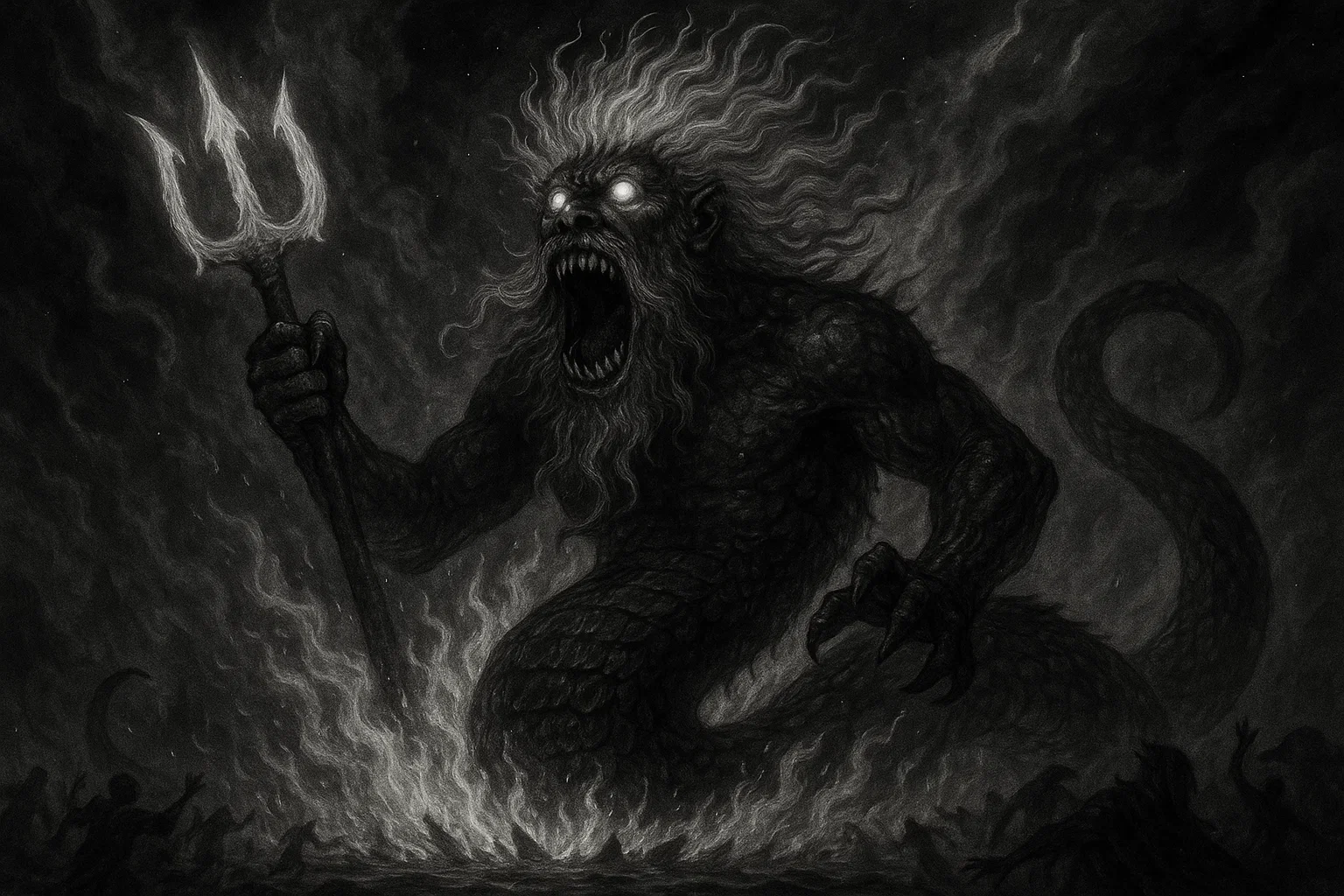Vritra is a key figure in Hindu stories, known as a danava—a type of asura. He stands for dry spells and blocks water flows, making him a big enemy to Indra, the king of the gods.
In ancient texts (like the Rig Veda), Vritra appears as a snake-like being called Ahi, who holds back rivers and causes hardship for people and gods alike. Indra fights him with a special weapon, the vajra, to free the waters and bring back life and growth.
Although often portrayed as a malevolent force, later stories in texts like the Bhagavata Purana depict Vritra as a follower of Vishnu, who meets his end in a manner that leads him to a higher realm. This mix makes him more than just a simple villain; he plays a crucial part in the larger balance between good and evil forces in the world.
Summary
Key Takeaways
| Attribute | Details |
|---|---|
| Names | Vritra, Ahi, Vrtra |
| Title | Personification of Drought, Leader of Danavas |
| Gender | Male |
| Role | Blocks waters causing drought, adversary of devas, symbol of chaos and obstruction |
| Clan | Danava |
| Followers | Asuras, Danavas |
| Powers | Enormous growth through austerity, causes earthquakes, swallows skies and universes, unconquerable strength, holds worlds on trident |
| Appearance | Serpent or dragon; tall and blackish like a burnt hill, copper-colored hair and beard, eyes like the midday sun, blazing trident |
| Etymology | From Sanskrit ‘vṛtra’ meaning ‘obstruction’ or ‘cover’, from root ‘vṛ’ to enclose or block |
| Associated Figures | Indra (enemy), Tvashta (father), Danu (mother), Vishnu (aider of Indra), Devas |
| Weaknesses | Vajra thunderbolt, ocean foam at twilight |
| Opposing Deva/Avatar | Indra, with aid from Vishnu |
| Pantheon | Hindu, with strong Vedic roots |
| Primary Sources | Rig Veda, Mahabharata, Bhagavata Purana |
“Vritra” Meaning
The name “Vritra” originates from ancient Sanskrit roots and holds profound significance in Hindu mythology.
In simple terms, “Vritra” means something that covers or blocks, like a large barrier that prevents things from flowing freely. This fits his role as the one who holds back rivers, leading to dry lands and hard times.
The word stems from the root vṛ, which means to enclose, surround, or hide. In older languages, such as Proto-Indo-European, the root ties back to wer-, also related to covering or shutting off. This makes Vritra a symbol for obstacles not just in nature, but also in life—like anything that stops progress or life-giving forces.
Over time, the definition grew in stories. In the Rig Veda, he’s called Ahi, meaning “snake,” indicating his form as a twisting creature that wraps around waters. This name shift highlights how myths change. Early texts focus on his blocking power, while later ones add human-like traits.
The full term Vṛtrá in Sanskrit is associated with ideas of enclosure, such as a cave or fort that traps things inside. Some experts see ties to similar words in other ancient languages, such as Avestan vərəθraγna, which means “slayer of obstacles”—flipping the idea to those who break barriers, much like Indra does to Vritra.
This etymology helps explain why Vritra is such a big deal in Hindu lore. His name isn’t just a label; it captures the struggle between order and chaos, flow and stagnation.
In battles with Indra (the thunder god breaks this cover to let rain fall), bringing life back. Variations across texts show slight changes: sometimes he’s pure evil, other times a complex being with devotion. For example, in Puranic stories, his name is associated with his immense size, which spans worlds through rigorous practice.
Scholars note that the meaning of the name “Vritra” may also be connected to real-world events, such as the dry seasons in ancient India. Rivers drying up would feel like a monster holding water hostage, so myths personify that fear.
In Tamil or other regional takes, similar ideas appear, but the Sanskrit roots stay core.
Overall, understanding this helps see Vritra as more than a demon—he’s a lesson on breaking through blocks, whether in nature or personal struggles. His etymology bridges old Indo-Iranian myths, where similar figures fight gods, showing shared roots in human stories about nature’s forces.
How To Pronounce Vritra in English
Say it as “VREE-tra,” with stress on the first part. The “V” is like in “victory,” “ree” rhymes with “free,” and “tra” like “truh.”
What Does Vritra Look Like?
In Hindu tales, Vritra often appears as a huge serpent or dragon, twisting like a snake to block rivers and cause dry spells.
This form comes from Vedic texts, where he’s called Ahi, meaning he coils around waters, holding them tight. His body is long and scaly, with a fierce appearance that strikes fear into the hearts of gods and people alike. Sometimes, he’s shown with many coils, like endless loops that trap everything inside. This snake shape fits his role as an obstacle, wrapping and enclosing.
Later stories in the Puranas portray him with a more human-like body, yet he remains frightening. The Bhagavata Purana describes him as tall and dark, like a burned mountain, shining like evening clouds. His hair, beard, and mustache are the color of melted copper, glowing red-orange. His eyes pierce like the midday sun, bright and hard to look at. He holds a blazing three-pointed spear, seeming to balance the whole world on its tips.
When he moves, the ground shakes like in a quake; when he yells, it’s loud and wild. His mouth opens wide as a cave, looking like it could swallow the sky, with a tongue licking stars and sharp teeth ready to eat the universe.
This mix of forms—snake and giant—shows his power. As a dragon, he breathes fear, linked to fire or drought that dries lands. His size grows daily, covering planets through hard work. In battles, he looks unbeatable, with a body that fills directions like arrows flying out.
These details from ancient texts portray Vritra as a force of nature, both beast and man-like, representing chaos that the gods must fight.
You may also enjoy:
Who Was Abezethibou, the Fallen Angel Who Opposed Moses?
October 1, 2025
Who Is Agaliarept, the General of Hell Under Lucifer?
October 8, 2025
Arati: The Beautiful Demon of Aversion in Buddhist Mythology
October 15, 2025
Marid: The Ocean Jinn That Defies Heaven and Earth
September 30, 2025
What Is Qarin and Why Does It Follow Every Human Being?
October 8, 2025
Abura-akago: The Oil-Licking Demon Baby
October 22, 2025
Origins
Vritra first appears in the oldest Hindu texts, the Rig Veda, as a blocker of waters and an enemy of Indra. This makes him one of the earliest Asuras, tied to natural events like dry spells. Over time, his story evolved into epics and Puranas, adding details such as his birth and devotion.
His tale starts with revenge. Indra kills Tvashta’s son, so Tvashta creates Vritra through a fire ritual. This shifts him from a simple nature symbol to a made being with purpose.
In later texts, Vritra leads the Asuras, showing his rise in myths. His defeat by Indra marks the triumph of order over chaos, a theme that persists throughout Hindu stories.
Birth
Vritra’s birth ties to anger and revenge in Hindu tales. His father, Tvashta, a skilled maker god, loses his son, Visvarupa (also known as Trisiras), to Indra. Visvarupa serves as a priest to the gods but shares secrets with Asuras, leading to his death. Hurt, Tvashta performs a fire ritual to create an enemy for Indra.
From the Bhagavata Purana: After Visvarupa dies, Tvashta offers into the fire, saying, “O enemy of Indra, grow to kill your foe without wait.” A scary figure comes from the south side of the fire, looking like the end of all at time’s close.
This being grows fast, like arrows in all ways. Tall and dark like a burned hill, he shines like evening clouds. His hair and beard are copper-colored; his eyes burn like noon sun. He seems unbeatable, holding worlds on his hot spear. Dancing and yelling loudly, he shakes the earth like an earthquake. Yawning, he tries to swallow the sky with a cave-deep mouth, licking stars with his tongue, eating all with sharp teeth.
This new being covers all star systems through hard work, so he’s named Vritra, one who covers all. Made to avenge, he starts as a tool of payback but becomes a big force, leading asuras against gods. His quick growth shows his power, born from ritual and rage.
Family
Vritra’s family links him to the Asura race. His mother is Danu, who gives birth to the Danava group of Asuras. His father is Tvashta, the maker god who creates him through a ritual to get back at Indra for killing Tvashta’s other son, Visvarupa. No brothers or sisters are named in the main texts, keeping his ties simple.
Tvashta shapes Vritra with care, endowing him with immense power and size. Danu ties him to other Danavas, known for their battles against the gods. In some stories, after Vritra dies, Indra also attacks Danu, illustrating the family fallout from the battle.
| Attribute | Details |
|---|---|
| Parents | Tvashta (father), Danu (mother) |
| Siblings | None |
| Spouse | None |
| Children | None |
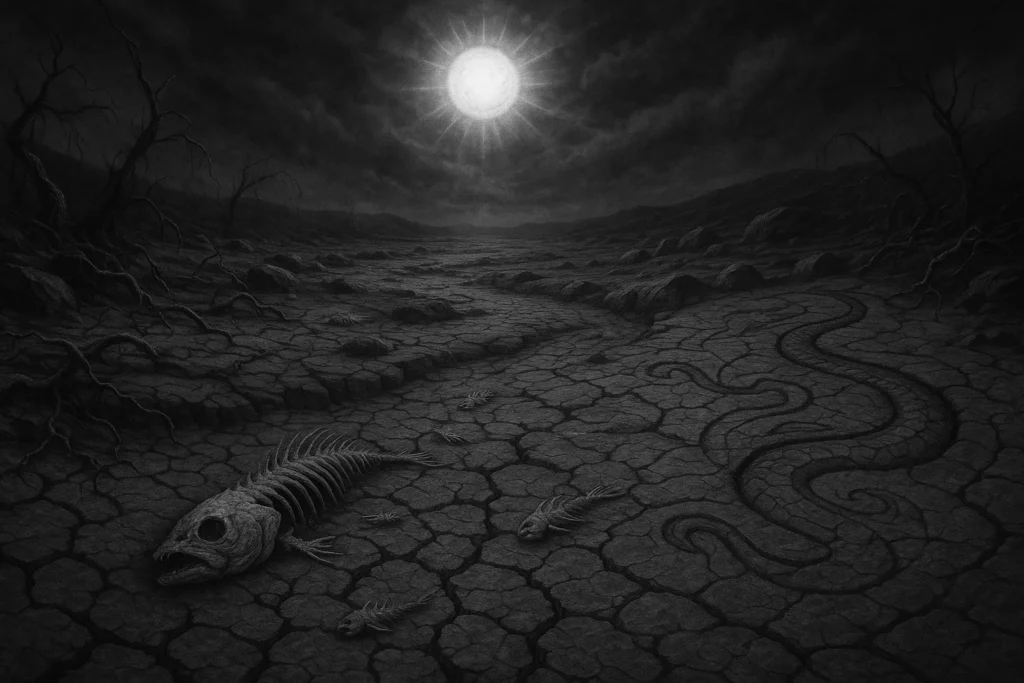
Asura-Deva Conflicts
Vritra plays a big part in the endless fights between asuras and devas, standing for mess against order. His main clash is with Indra, where he blocks rivers, causing dry lands and starving people. This fight is central to Hindu tales, illustrating the battle for balance and the right path.
In the Rig Veda, Indra drinks soma for strength, then strikes Vritra with the vajra made by Tvashta. Vritra breaks Indra’s jaws, but Indra throws him down, smashing his forts and freeing the waters. Vishnu helps by stepping wide to make space. Some gods, such as Varuna, Soma, and Agni, switch sides to aid Indra.
In the Puranas, Vritra wins first, swallowing Indra, but the gods make him spit him out. Indra hides, then a deal is made: no attack with metal, wood, stone, dry, wet, day, or night. Indra uses sea foam at dusk to kill him. The fight lasts 360 days; Vritra advises Indra even in death, showing devotion. This win upholds dharma, releasing waters and restoring life, but Indra faces sin for killing a brahmin-linked being.
You may also enjoy:
Who Is Abalam in Demonology? The Terrifying King That Serves Paimon
September 30, 2025
Si’la: The Seductive Jinn Who Lures Travelers to Their Doom
October 9, 2025
Vaisravana: The Golden Guardian King Who Rules the North
October 16, 2025
Abura-akago: The Oil-Licking Demon Baby
October 22, 2025
What Is the Abumi-guchi Yōkai and Why Does It Wait Forever?
October 22, 2025
Mahakala: The Dark Guardian Who Consumes Evil
October 16, 2025
Role in Hindu Cosmology
Vritra fits into the larger cycle of dharma, where opposing forces clash to maintain balance. As a blocker of waters, he stands for dry spells and mess, upsetting the flow of life and rebirth.
His defeat by Indra brings rain and growth, illustrating how evil forces must fall for good to prevail. Yet, in some tales like the Bhagavata Purana, he’s a follower of Vishnu, killed for turning to harm but reaching a high place after death. This makes him less a pure villain, more a tool in the cosmic play.
He affects both gods and humans by controlling the rains, causing hunger and fear. His story teaches that obstacles, like dry times, are part of life but can be overcome. As the head of the Asuras in later texts, he leads fights against the Devas, pushing the wheel of time and change.
His end stresses the importance of living right; even strong beings fall if they break the dharma.
Was Vritra Ever Mentioned in Vedic Texts?
Yes, Vritra appears frequently in Vedic texts, primarily in the Rig Veda, as Indra’s main foe. Hymns praise Indra for slaying him, freeing the waters. For example, in Rig Veda 1.32, it details the fight with Vritra as a dragon. Translations vary; some see him as a real snake, others as a dry spell symbol. In Hindu thought, this victory signifies order over chaos, with Indra as the protector.
Other texts, such as the Atharva Veda, mention him less. Still, the Vedic focus is on his defeat by Indra, often accompanied by soma and the vajra. Interpretations reveal ecological ties, such as ending dry seasons.
| Source | Quote |
|---|---|
| Rig Veda 1.32.14 | Whom sawest thou to avenge the Dragon, Indra, that fear possessed thy heart when thou hadst slain him; That, like a hawk affrighted through the regions, thou crossedst nine-and-ninety flowing rivers? |
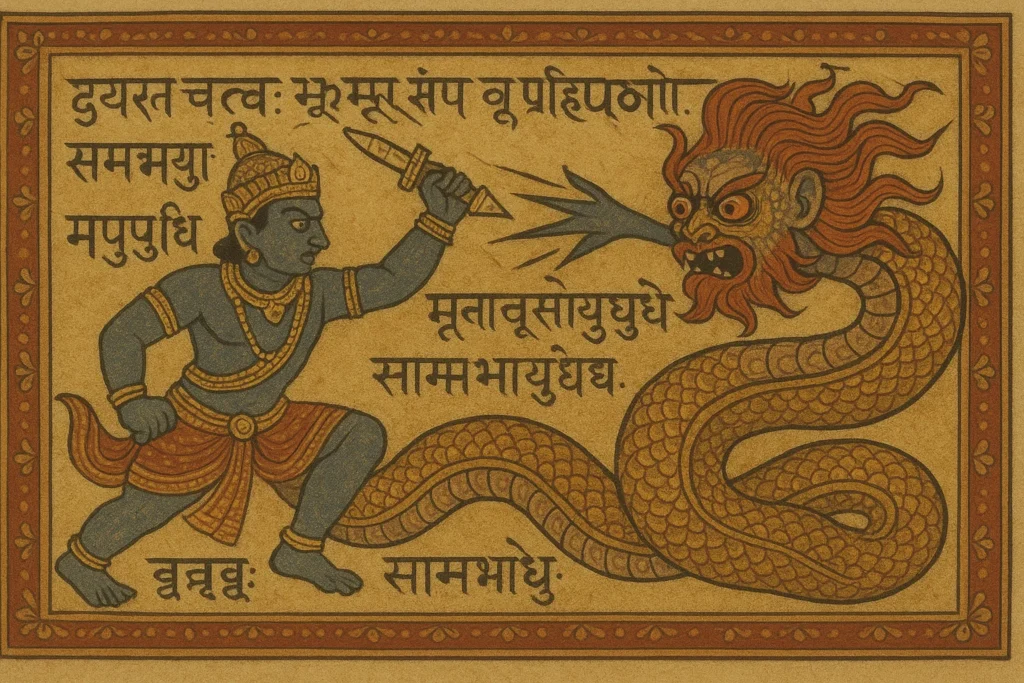
Vritra in Epics and Puranas
Vritra is mentioned in the Mahabharata, as told to King Yudhishthira, and in Puranas such as the Bhagavata Purana. In the Mahabharata, he’s created by Tvashta for revenge, swallows Indra, and leads to a truce and death by foam. Valmiki’s Ramayana mentions him less, but epics build on a Vedic base.
In the Bhagavata Purana, the author Vyasa portrays him as a devotee, slain but ascending. Epithets include “coverer” and “dragon.”
| Source | Quote |
|---|---|
| Bhagavata Purana 6.9.11 | After Visvarupa was killed, his father, Tvashta, performed ritualistic ceremonies to kill Indra. He offered oblations in the sacrificial fire, saying, ‘O enemy of Indra, flourish to kill your enemy without delay.’ |
| Bhagavata Purana 6.9.12 | Thereafter, from the southern side of the sacrificial fire known as Anvaharya came a fearful personality who looked like the destroyer of the entire creation at the end of the millennium. |
| Bhagavata Purana 6.9.13-17 | Like arrows released in the four directions, the demon’s body grew, day after day. Tall and blackish, he appeared like a burnt hill and was as lustrous as a bright array of clouds in the evening. The hair on the demon’s body and his beard and moustache were the colour of melted copper, and his eyes were piercing like the midday sun. He appeared unconquerable as if holding the three worlds on the points of his blazing trident. Dancing and shouting with a loud voice, he made the entire surface of the earth tremble as if from an earthquake. As he yawned, again and again, he seemed to be trying to swallow the whole sky with his mouth, which was as deep as a cave. He seemed to be licking up all the stars in the sky with his tongue and eating the entire universe with his long, sharp teeth. Seeing this gigantic demon, everyone, in great fear, ran here and there in all directions. |
| Bhagavata Purana 6.9.18 | That very fearful demon, who was actually the son of Tvashta, covered all the planetary systems by dint of austerity. Therefore, he was named Vritra, or one who covers everything. |
| Mahabharata 5.9 | The terrible anthropomorphic personification of Brāhmanahatya chased Indra and forced him into hiding for his sin. |
Powers and Abilities
Vritra is a powerful Asura. His powers and abilities include:
- Huge Growth: His body expands daily like arrows in all directions, covering star systems through hard practice.
- Earth-Shaking Strength: Dancing and yelling cause quakes, making the ground tremble.
- Swallowing Power: Mouth like a cave swallows sky, licks stars, eats universe with sharp teeth.
- Unconquerable Look: Holds three worlds on blazing spear points, seems unbeatable.
- Battle Prowess: Wins against Indra at first, swallows him and his elephant whole.
- Austerity Might: Gains upper hand over gods through strict self-control, scaring them.
- Destructive Force: Blocks rivers, causes dry spells and hunger, personifies mess.
Vritra Myths, Legends, and Stories
Indra Slays Vritra in the Rig Veda
Soon after Indra comes into being, he goes to Tvashta’s home and drinks a great amount of soma to gain strength before facing Vritra. Tvashta crafts the thunderbolt for Indra, and Vishnu creates room for the clash by taking three large steps.
The fight starts, and Vritra shatters Indra’s two jaws. But Indra hurls Vritra to the ground, and in dropping, Vritra crushes the strongholds that were already broken. For this, Indra attacks Danu and beats her with his bolt.
Three gods—Varuna, Soma, and Agni—who were once with Vritra, calling him father, change sides to help Indra.
Vritra’s Creation and Battle in the Bhagavata Purana
After Visvarupa is slain, his father, Tvashta, does rites to end Indra. He puts offerings in the fire, chanting, “O foe of Indra, thrive to end your rival without holdup.”
Then, from the south of the flame called Anvaharya emerges a scary being who seems like the wrecker of all at the era’s end. Like darts shot in four paths, the fiend’s form enlarges, day by day. High and shadowy, he looks like a scorched peak and gleams as a vivid group of vapors at dusk.
The locks on the fiend’s frame and his whiskers and mustache are the hue of fused bronze, and his gaze is stabbing like the noon glow. He seems invincible, as if grasping the three realms on the tips of his flaming fork. Leaping and bellowing with a booming sound, he causes the whole face of the land to quiver as if from a tremor.
As he gapes over and over, he appears to attempt to gulp the entire heavens with his jaws, which is as profound as a cavern. He seems to lap up all the lights in the sky with his licker and consume the whole cosmos with his lengthy, keen fangs. Viewing this massive fiend, all, in huge dread, dash this way and that in every route.
That very scary fiend, who was truly the child of Tvashta, enveloped all the star setups by force of strictness. Thus, he gets titled Vritra, or one who envelops all. Vritra turns to harm, clashing with the gods. At last, he takes the lead, and the gods fear his bad power.
Guided by Indra, they seek Vishnu for aid. Vishnu tells them to go to the wise Dadhichi. Dadhichi offers his bones; Indra makes the vajra from them. The clash lasts for 360 days before Vritra takes his final breath. In the fight, Vritra gulps Indra entirely, with Airavata, but Indra breaks free and cuts off his head with the vajra.
In Vaishnava views, Vritra is a devotee of Vishnu; when struck, he tells Indra to grasp his arm, thinking that life and death are alike as tools of Vishnu. Vritra rises to Vaikuntha upon his passing.
You may also enjoy:
Ifrit: Demon of Fire Who Serves Iblis in Islamic Tradition
September 30, 2025
Abura-akago: The Oil-Licking Demon Baby
October 22, 2025
Who Are the Yaksha, and Why Did Buddhists Fear Their Wrath?
October 20, 2025
The Ghul: The Flesh-Eating Demon of Arabian Folklore
October 1, 2025
Arati: The Beautiful Demon of Aversion in Buddhist Mythology
October 15, 2025
Who Is Abaddon, the Demon of the Abyss, in the Bible?
September 29, 2025
The Truce and Death in the Mahabharata
Vritra triumphs in the clash and gulps Indra, but the other gods make him spit Indra out. The fight continues, and Indra is finally forced to flee. Vishnu and the wise ones make a peace, with Indra vowing he would not strike Vritra with anything of metal, timber, or rock, nor anything that was parched or damp, nor during the light or dark.
Indra uses the bubbles from the sea waves to end him at gloaming. The awful human-shaped form of Brahman-killing pursues Indra. It pushes him into concealment for his wrong, and Nahusha is asked to fill his spot.
Vritra vs Other Asuras
| Asura Name | Associated Trait/Role | Clan/Origin | Key Traits/Powers |
|---|---|---|---|
| Hiranyakashipu | Conquest and tyranny | Daitya | Boons from Brahma, near-invincibility, shape-shifting |
| Hiranyaksha | Earth abduction | Daitya | Immense strength, boons, battles Varaha |
| Bali | Generosity and rule | Daitya | Devotion, boons, conquers heavens |
| Ravana | Warrior and scholar | Rakshasa | Ten heads, boons from Brahma, shape-shifting |
| Mahishasura | Buffalo demon | Asura | Shape-shifting, battles Durga |
| Narakasura | Kidnapper of women | Asura | Boons, immortality except by mother, dark powers |
| Andhaka | Blind warrior | Asura | Regeneration, battles Shiva |
| Banasura | Thousand arms | Asura | Boons from Shiva, immortality except by certain foes |
| Taraka | Invincible warrior | Asura | Boons from Brahma, slain by Kartikeya |
| Shumbha | Leader of army | Daitya | Strength, battles Devi |
| Nishumbha | Brother warrior | Daitya | Combat skills, slain by Kali |
| Raktabija | Blood regeneration | Asura | Clones from blood drops |
| Madhu | Chaos creator | Daitya | Immense power, battles Vishnu |
| Kaitabha | Deception | Daitya | Strength, slain by Vishnu |
| Sambara | Illusion master | Daitya | Magical illusions, battles Pradyumna |
Rank Among Asuras
Vritra holds a high position among Asuras, especially as the head of the Danavas in Puranic tales. As a Danava, he’s part of the Asura group, but his role as leader stems from his power and his fights against the devas.
In Vedic texts, he’s a main foe without a clear rank, but later stories make him chief, turning to harm and leading the Asura forces.
His ties with other asuras are through clan; as Danu’s son, he links to danavas known for clashing with gods. No direct helpers are named, but he commands fear among asuras.
His rivalry with the devas reaches its peak in battles with Indra, where the gods unite against him. This makes him a symbol of Asura’s might, but his demise reveals that Deva ultimately wins.
In the broader context, Vritra’s role highlights the balance between the Asuras and the Devas. He’s not just a fighter but a blocker whose defeat frees life. Compared to others like Hiranyakashipu, he’s more nature-tied, less about personal rule. His devotion in some tales sets him apart, making him an anti-hero among the Asuras.
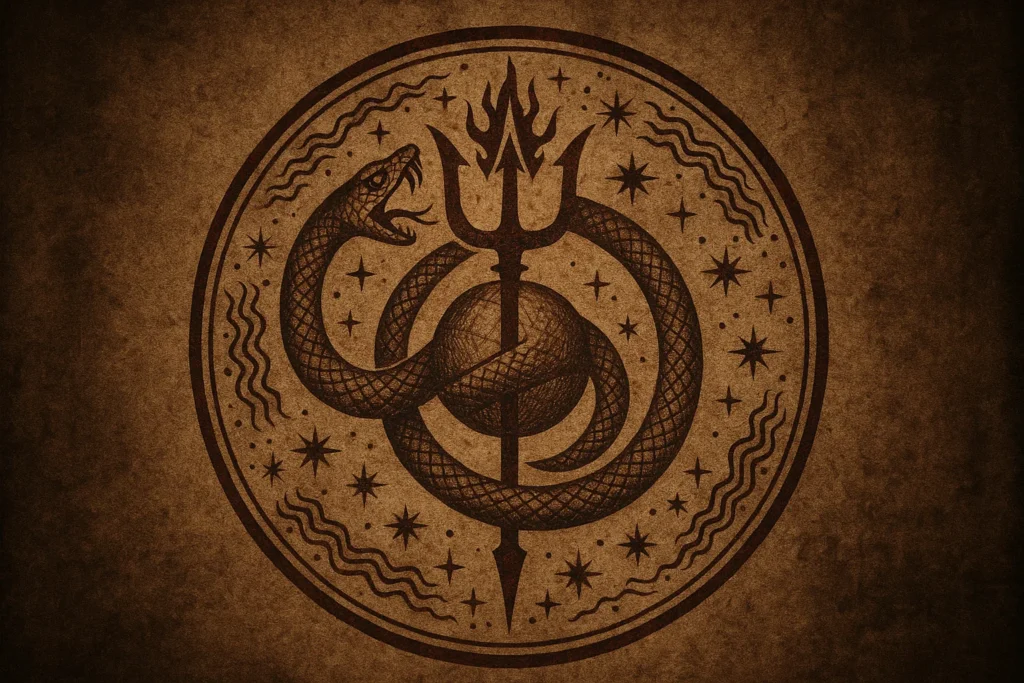
Mystical Correspondences
| Attribute | Details |
|---|---|
| Planet | Saturn |
| Zodiac Sign | Scorpio |
| Element | Water |
| Direction | West |
| Color | Black |
| Number | 99 |
| Crystal/Mineral | Onyx |
| Metal | Iron |
| Herb/Plant | Cactus |
| Animal | Serpent |
| Trait/Role | Obstruction |
Mystical Correspondences
Vritra’s sky links ground his force in the stars, with Saturn as his ruling world, standing for blocks and hard times. Saturn drives his holding of waters, as seen in his fights with Indra, with rites to call his might often set to Saturn’s strong times, such as Saturdays or the Capricorn season. His zodiac mark, Scorpio, flows with hidden depths and change, pushing his sly hold on rivers.
This star setup boosts his blocking skill, as in Vedic stories where Vritra’s coils grip the skies, testing Indra. Calling Vritra in these spans, as in some old ways, strengthens his hold, matching his stop energy with sky turns.
Shifting from stars to earth, Vritra ties to the water part, showing his rule over flows; he stops them, causing dry lands. In myths, his snake form wraps waters, while his huge body covers lands like a flood held back.
This water link goes to the west, the way of sunset, and ends in Vedic views, where Vritra’s dark city of forts looms. Water bowls, used in tales of his block, guide this shifting energy, keeping his hold strong. His water side also shows in his swallow of Indra, flowing like a river turned bad, marking his skill to rule both land and wave.
These ties help grasp Vritra’s core as a force of stop and mess. Colors like black match his dark, hill-like look, standing for the unknown and fear.
Numbers like 99 are tied to his many forts, which were broken by Indra, showing full blocks.
Crystals such as onyx guard against his negative energy, while iron suits his hard, unbreakable side.
Plants like cacti thrive in dry environments, mirroring their role in drought, and animals like serpents capture their twisting form.
Together, these symbols portray Vritra as a lesson in overcoming barriers, whether harmful or those that drive growth.
Vritra’s Symbols
Vritra is linked to signs like the snake, showing his coiling block of water. His three-pointed spear stands for his hold on worlds, a tool of wreck. Drought itself is his mark, as he personifies dry times. In some views, forts or caves symbolize his enclosing power, trapping flows inside.
Worship and Boons
Vritra gains his might through hard practice, covering star systems with strict self-control. No common worship exists, as he’s a foe to gods, but his story shows penance power.
In the Puranas, a peace deal acts like a guard: Indra vows not to strike with metal, wood, stone, dry or wet, day or night. This lets Indra use sea bubbles at gloaming, with Vishnu inside, to end him.
In the Bhagavata Purana, the gods fear the harm that Vritra will inflict on earth. Vishnu blesses that he will come as a human to kill, since Vritra’s guard skips humans. Dadhichi gives bones for the vajra.
Vritra sees his end as a blessing, as the arm holds the power of Vishnu and Dadhichi. This shows how boons and rites shape fates, even for asuras.
You may also enjoy:
Marid: The Ocean Jinn That Defies Heaven and Earth
September 30, 2025
The Ghul: The Flesh-Eating Demon of Arabian Folklore
October 1, 2025
Arati: The Beautiful Demon of Aversion in Buddhist Mythology
October 15, 2025
Who Is Jann in Islamic Mythology and Why Is He Feared?
October 2, 2025
What Is Qarin and Why Does It Follow Every Human Being?
October 8, 2025
Mara: The Buddhist Demon King of Desire and Death
October 13, 2025
